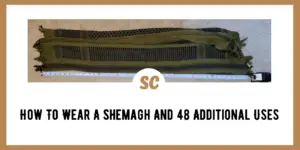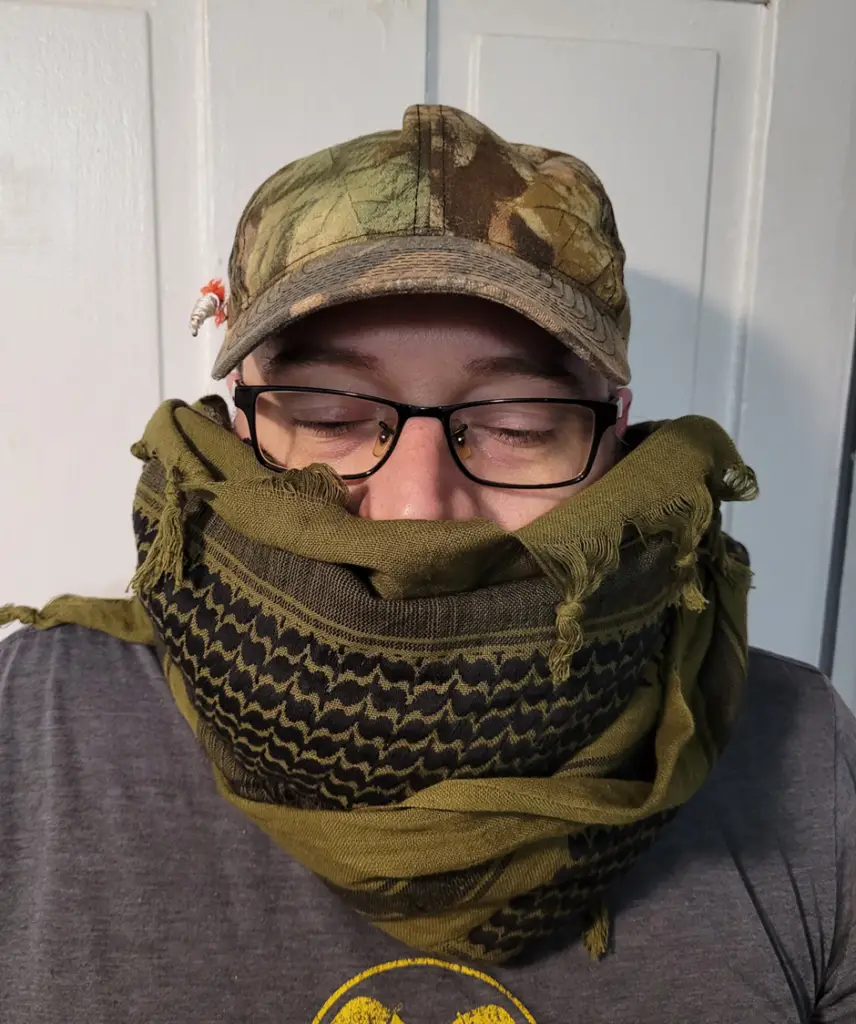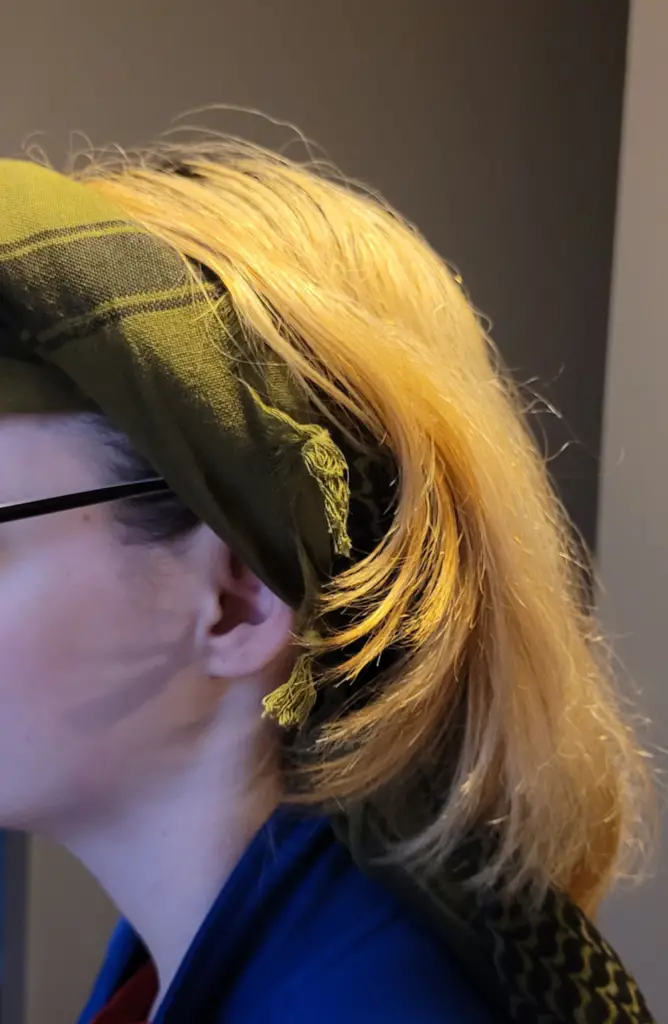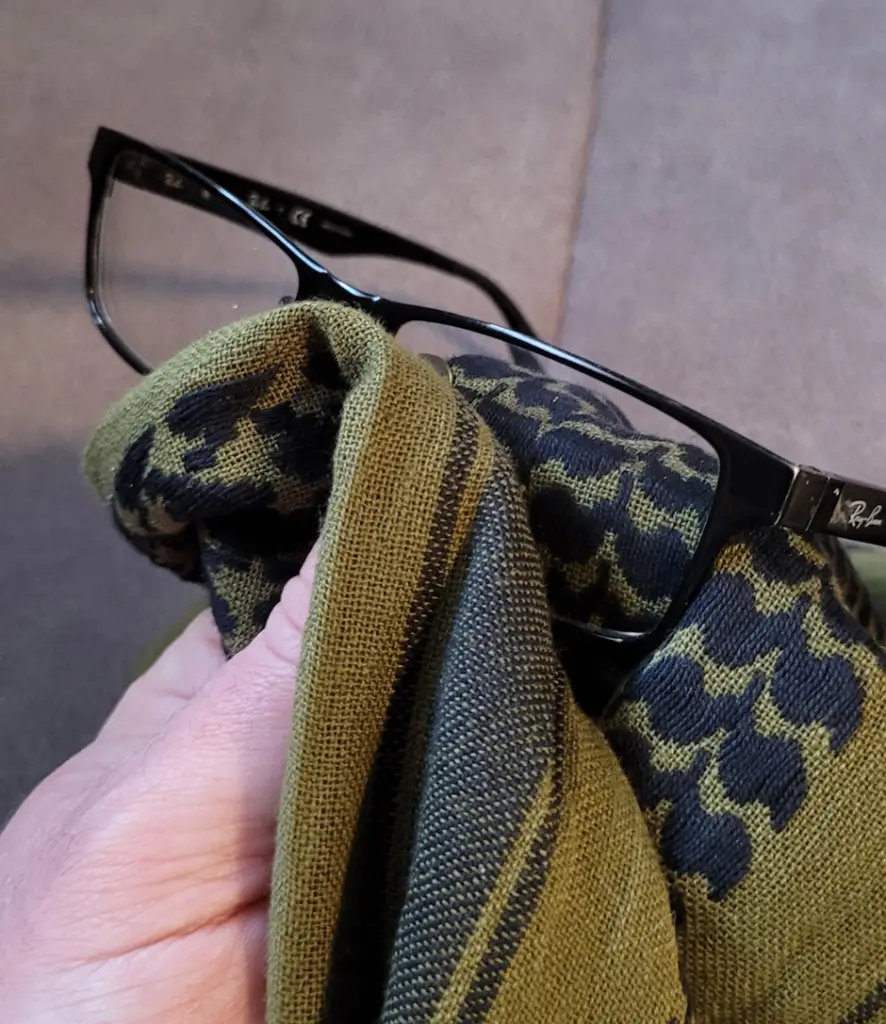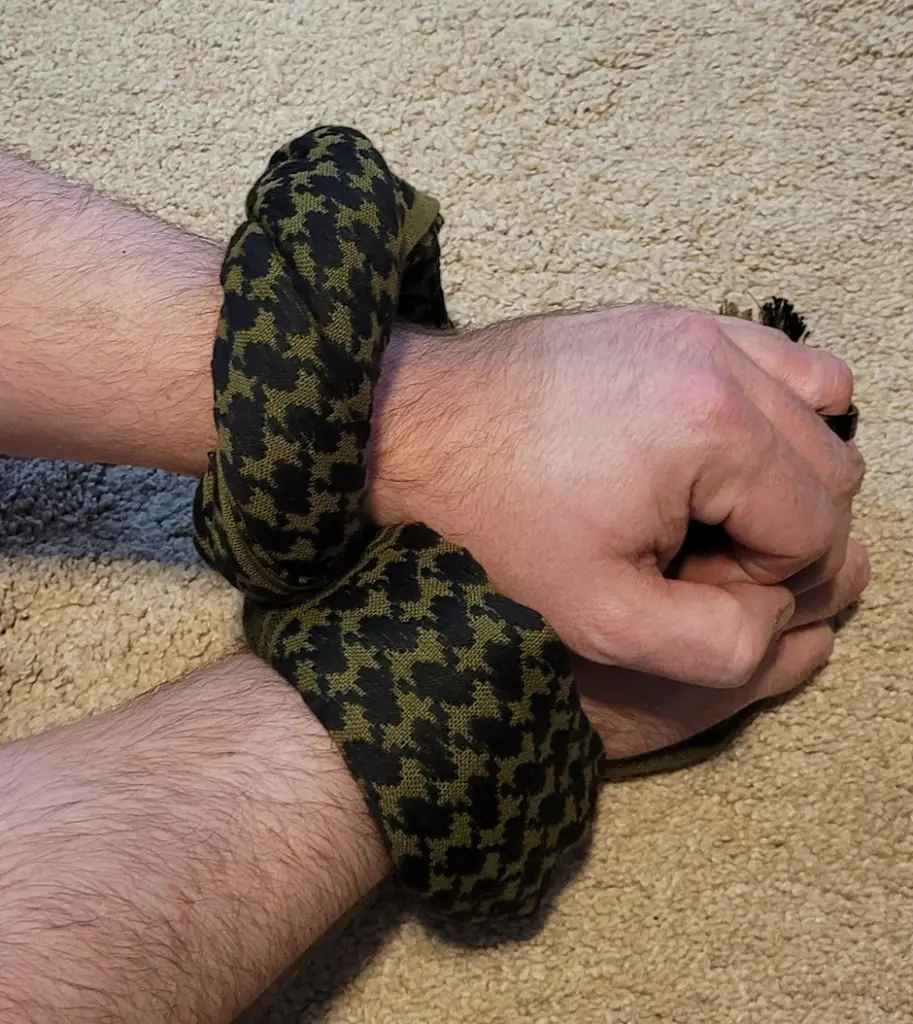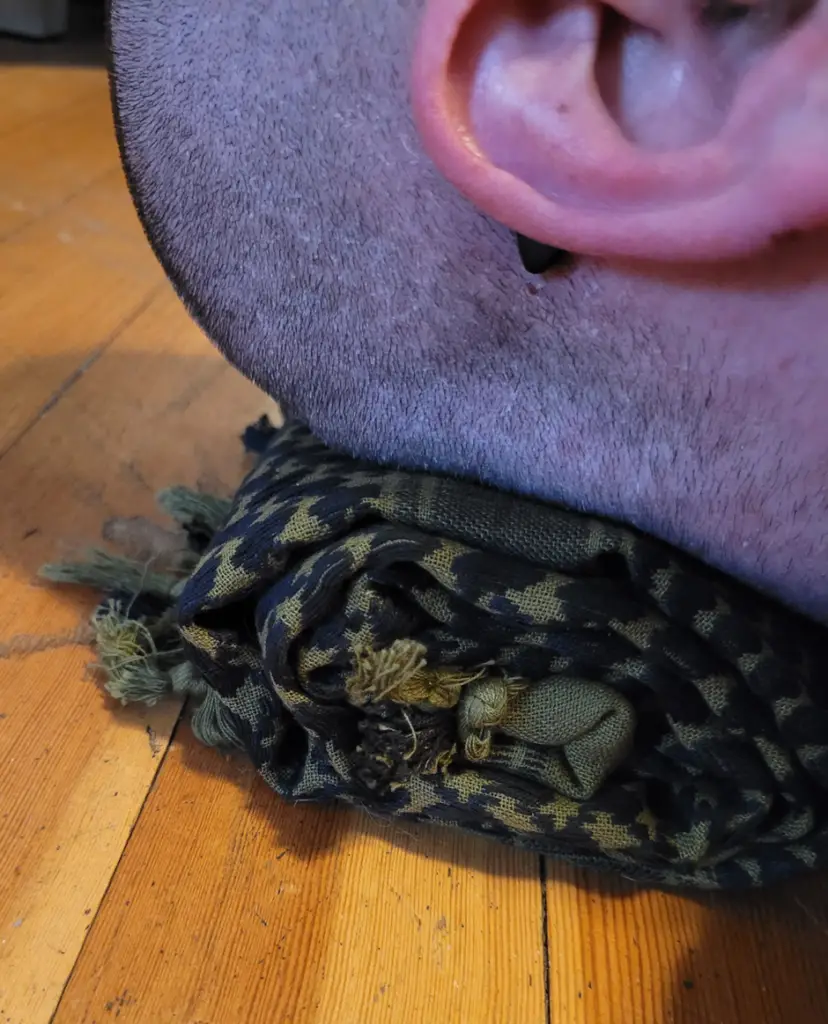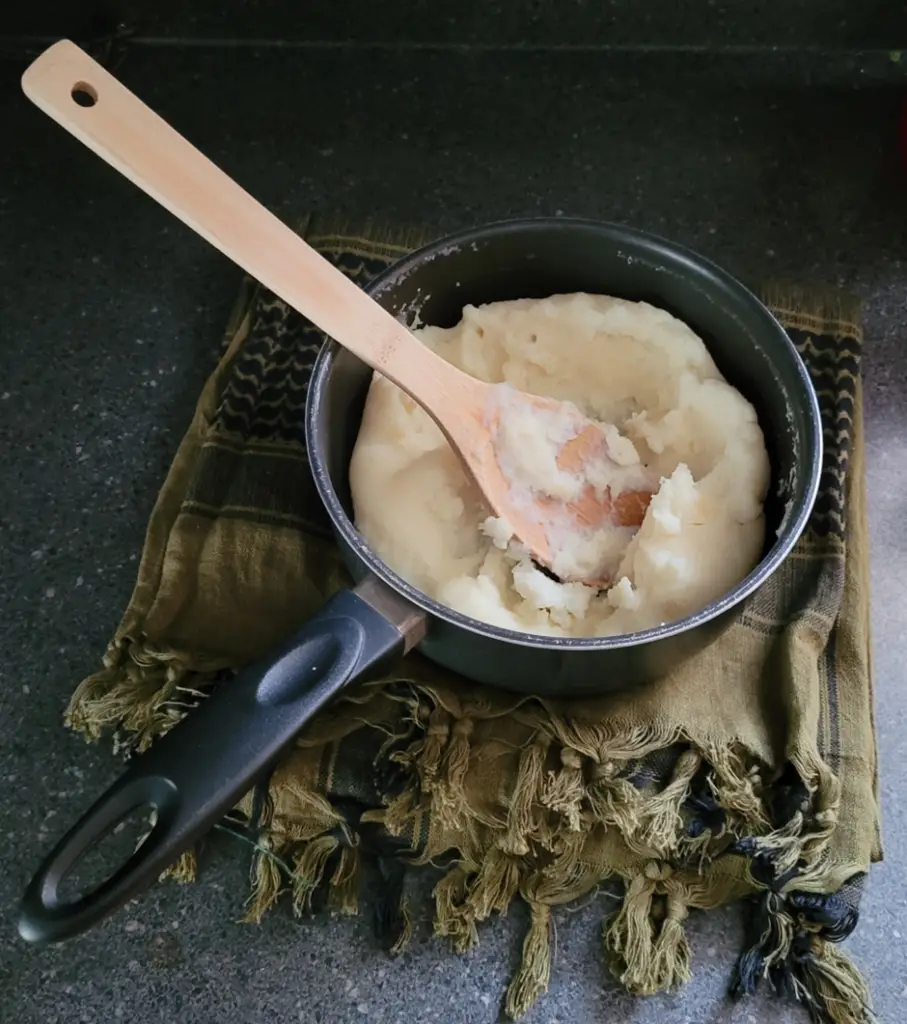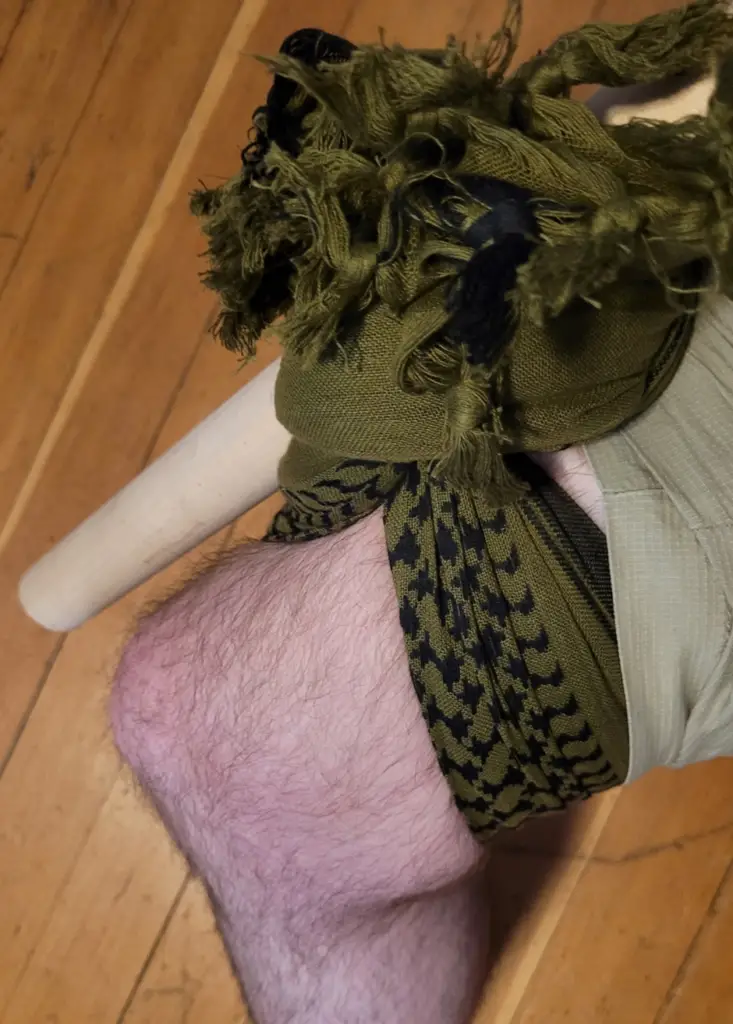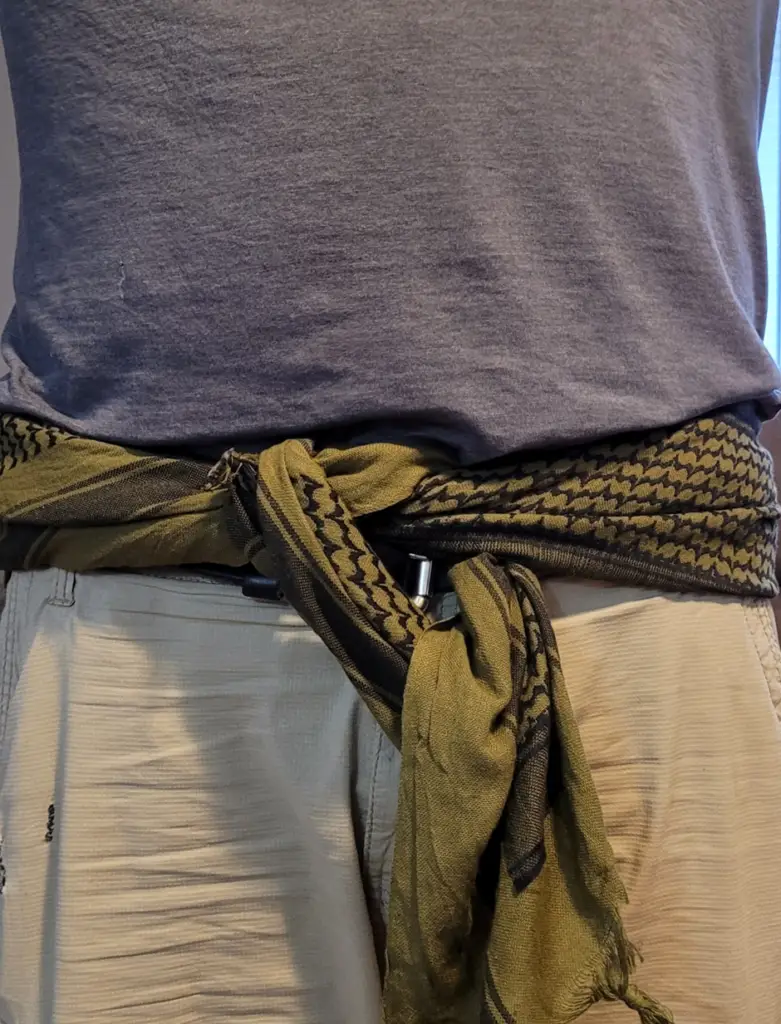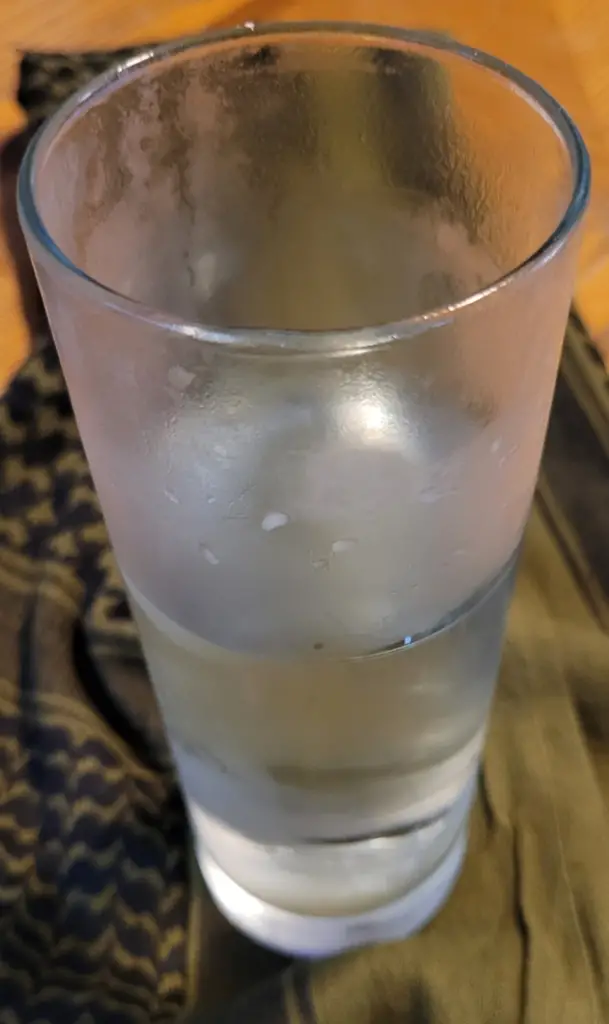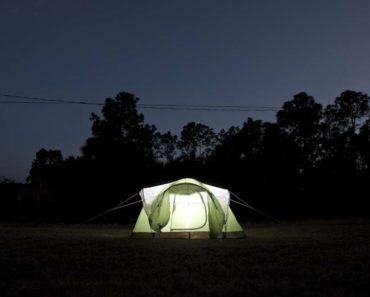If you are on this site, then I’m pretty sure you know what a shemagh is. Even if you don’t, I’m willing to bet you have least seen them.
The shemagh has been around for a long time, and originated it in the middle east. It’s used a lot in arid regions as a head wrap to provide sun protection, dust protection, and a barrier against wind or sand.
It didn’t really become popular worldwide until soldiers and military forces operating in arid regions (like the Afghanistan wars) began adopting their use from middle eastern units and the local population. So, if you have been alive in the last, oh let’s say 50 years, I’m sure you have seen them pictured in the news, television, movies, and even in the fashion industry.
However, other than looking “cool,” this items is a very functional article to wear and it has a surprising number of other uses, whether that be in your daily life or in times of an emergency.
In this article I will be covering:
- 4 Common ways to wear a shemagh
- Step-by-step instructions for how to wrap a shemagh
- 48 additional ways to use it
Since the shemagh is primarily a head wrap, let’s start with how to wear it.
4 Ways to Wear a Shemagh
There are a lot of ways that this material can be worn, but below I have listed four common methods that I have seen and how to tie a shemagh:
1. Classic Approach
This traditional method is how a shemagh is commonly worn because it provides protection from the sun on all sides of the head and around your neck. The front can be worn either down or pulled up over the chin, nose, and mouth during harsh weather conditions.
There are much cleaner methods for this wrapping style, but here is the quick and dirty way I was shown years ago to wrap and tie a shemagh:
- Lay the fabric out to create a full square
- Bring two corners together to form a large triangle
- Place the base of the triangle with the folded edge on top of your head or on your forehead (like you would when wearing a bandanna)
- Grab the left corner that is hanging down and bring it up, over your nose and mouth, around the neck, and over the right shoulder. Hold this in place with your right hand
- Now, grab the right corner of the fabric that is hanging down with your left hand, bring it under your chin, over the left shoulder, and around your neck
- Pull the two ends completely around your neck and back shoulders, and tie the corners into a knot
- Before or after tying the knot, you may need to make some final adjustments depending on how tight or loose you want the wrap covering your head
- It doesn’t matter if you want to start on the left side or the right side, just use the same steps as above, but in reverse
2. Bandanna or Do-Rag
I love bandannas and I can’t even tell you how long I’ve been carrying one around. I generally use them for utility purposes rather than wearing it on my head, but I do rock the “biker”/do-rag look from time to time. A shemagh is basically a giant bandanna, so it can be worn in the exact same way. You can use whatever method you use to wear a bandanna, but below is what I do:
- Spread the material out so it forms one big full square
- Bring two opposite corners together to create a triangle
- Then place the middle of the base of the triangle, the folded edge, onto your forehead
- Bring the left and right corners over your shoulders, around the back of your head, and tie them in a square knot.
3. Loose Neck Scarf
You may want to have a shemagh with you, but what if you don’t want or need it as a head covering?
Answer: wear it like a scarf.
Simply wrap the material around your neck like you would your favorite scarf. There may be more material than you need, so continue wrapping the fabric around your neck until it suites your needs, or simply let the two ends hang down.
This wrap would work great on a cold day because it covers my neck, nose and mouth, and ears.
4. Hair Band
The easiest way to do this is to fold or wrap the material into a thin “rope.”
Then pull back your hair, pace the material just above the forehead, wrap the two ends behind and underneath your hair, bring the two corners together and finish it off by tying the ends into a single knot or two overhand knots.
48 Ways to Use a Shemagh
I have gone over a few ways to wear a shemagh and the reasons for them, but it is so much more versatile than just a head covering.
I mentioned earlier that I love bandannas, and that’s because they have a ton of different uses. A shemagh is no different. So, let’s discuss some of the other interesting ways that this item can be used during your daily life or during an emergency:
- Handle Cushions
Sometimes you may have to carry a load of bags, buckets, wood, or some other object, and you might have to carry them a long distance. Or you may have to use some tool for hours at a time. It’s very possible that these items don’t have a cushioned handle, or the cushion has worn out.
You can better protect your hands and be more comfortable by wrapping the fabric around the handle or wherever your hands make contact with.
- Fishing Net
Shemaghs come in different sizes, but they are generally quite large. The one pictured throughout this article measures roughly 42 inches. This could easily be used to create a dip net for catching fish or other critters.
- Patching Material
Our clothes and gear can only put up with so much use and abuse before they start to wear out. If an article of clothing rips or tears, pieces of the shemagh could be cut out and used as patching material.
- Cool Down Towel
We’ve already gone over that wearing a this material on the head can keep you cool. You can increase its cooling ability by soaking the fabric in water before placing it back on your body.
- Handkerchief
Yeah, I know this may seem gross, but sometimes you got to blow your nose or wipe your kid’s nose. A least a shemagh is big enough that you can keep the “grossness” isolated to a small area.
- Clean Your Gear
The shemagh I have is made from 100 % cotton, so I would feel comfortable using it to clean my sunglasses, binoculars, other optics, or any gear that needs a wipe down.
- Washcloth
Most of us like a good, hot shower to clean up at the end of the day, but sometimes those facilities aren’t available. In their absence, proper hygiene is still important, and this item can be used as a washcloth to clean your pits and bits.
- Drying Towel
On the other hand, you can skip the washcloth altogether and just stand under a waterfall or slide into a calm pool of water. When you get out, you can use the shemagh to quickly dry off and go about your day.
- Tie Up a Bad Guy
Cloth isn’t the best option for improvised handcuffs, but when you need to subdue a bad guy, you gotta use what you’ve got.
- Make Cordage
Cordage is incredibly versatile and has too many uses to list here. If you find yourself without cordage, use a sharp knife to cut stripes of fabric and tie the ends together to create one long end. Or, cut out a spiral pattern starting in the center to create a continuous piece.
- Miniature Pillow
We are very used to our creature comforts like a pillow, but many of us don’t carry one around with us. Unless, of course, you have a shemagh.
You can fold it over several times onto itself, or it can be folded over once and stuffed with soft material. It won’t be as good as the one in your bed, but it’s better than nothing.
- Charcloth
Getting a fire going can be quite the challenge, but once you have one burning you should use it to its full potential. In this cas,e that means preparing tinder to start the next fire. If the shemagh is made out of 100% cotton it can be turned into charcloth, which takes a spark extremely well.
- Blaze a Trail
Blazing a trail can be done by breaking foliage as you travel and if you need markers, then cut small strips of fabric and tie the corner to branches along your way.
- Signaling Device
A shemagh, especially a brightly colored one, makes a great signaling device for getting the attention of people in your group or a rescue team.
- Defend Yourself
Two quick ways to use a shemagh to defend yourself both involve adding a weight or rock into one corner of the material. Once the weight is in the shemagh it can be swung and released like a rock sling or it can simply be used to swing the weight.
- Heave a Rope
Getting a rope or piece of cordage over a tree branch can be a pain in the butt. It’s much easier if the rope has some weight on the end. Secure some rocks or other weight in the shemagh, and then tie the shemagh to the end of the cordage. Instant cordage weight!
- Potholder
Have you ever tried using sticks as improvised tongs to remove a pot from a campfire? There is a good chance it will end in disaster by spilling whatever it is you are cooking. Save your water or food from spills by folding the shemagh onto itself several times to create a potholder. This can also be used at home to pull out an oven rack or grab a hot cast iron pan.
Speaking of food…
- Set the Table
Sometimes you just want a nice clean place to set your meal on. Instead of putting it on the ground, lay out the shemagh picnic-style to create an improvised tablecloth. This will also help with clean up because when you are done simply pile everything into the center of the shemagh and carry it away.
- Water Collector
Staying hydrated is important, especially after a meal, and a shemagh is a great tool for collecting water. There are several ways this can be accomplished:
- It can be used to soak up morning dew
- It can be used like a sponge to soak up water in small puddles
- It can be used like a press to squeeze out water from wet vegetation
- Water Filter
To use a shemagh as a water filter, fold it over onto it self several times to create many layers.
Then, place it over the top of your water bottle and place the bottle into the water source and allow the water to seep through. This will only filter out large debris that you can see. After this step, water still needs to be purified (boiled) after filtering.
- Create Shade
A shemagh can help you to stay cool by wrapping it on the head, or by soaking it in some cool water. However, there is another way it can be used to bring your temperature down.
Since a shemagh is so large, it can be stretched out overhead and anchored to provide some much-needed shade. Shaded areas out of direct sunlight can drastically reduce the temperature of the area and help your body cool down.
- Blanket
A shemagh is great at helping you stay cool, but it can also help warm you up by using it as a small blanket or by stuffing it into your clothing for additional insulation.
- A Bag
Need a way to transport food or any other small resources that you have found? Place the items in the middle of the shemagh, and pull the four corners together to create a simple carrying bag.
- Carrying Sack
If you need to carry items for a longer distance and want them more secure, use the shemagh to create a sack that is easier to carry. This can be tied to the end of a stick and balanced over the shoulder, tied to an improvised pack frame, or wrapped around your midsection.
Leaving food out on ground level is an invitation for a free meal to animals and other critters. Keep your food safe by packing it into a shemagh and hanging it up high.
- Joint Pads
Some of us don’t have the best joints anymore, or maybe yours are just sore and tender from so much physical activity. Either way, give your knees or elbows a rest from hard surfaces by using the shemagh as a knee pad or elbow pad.
- Dust Mask
Breathing in dust, sand, or smoke is a quick way to ruin your day. Use the shemagh to cover your nose and mouth for protection. If you can spare some water, wetting the fabric will help even more to keep blown dust or other hazards at bay.
- Tourniquet
Use a shemagh as an improvised tourniquet to deal with uncontrolled bleeding. This is not a replacement for a proper tourniquet, which should always be carried, but the shemagh can be used in this manner as a last-ditch effort.
- Bandages
Scrapes and cuts abound, but no first aid kit to be found? A shemagh can be used to cover large injured areas, or it can be cut into smaller pieces as necessary to keep wounds as clean as possible.
- Arm Sling
Keeping an injured arm immobile can be tricky, but a shemagh makes a decent improvised arm sling.
- Splint Tie
Another method for helping to keep joints immobile is by using a splint. If you are improvising this, you’ll need a way to tie it off and secure it. The shemagh can be used as cordage to keep the splint held together.
- Eye Patch
Have an injured eye and don’t have any tape or a way to keep an eye pad in place? The shemagh can be used to help hold everything together, or it can be used as the patch itself.
- Tool Lanyard
I ‘ve lost my fair share of tools because I wasn’t using a lanyard. To keep your tools from slipping away into oblivion, tie off the handle of a tool or piece of gear with a shemagh, and the longer side to create a tool loop that you can hold on to.
- Improvised Gloves
Gloves get worn out, lost, or you just don’t have a pair. Either way, wrap your hands in a shemagh to help keep them warm or to protect them from a surface you don’t want to touch.
- Strap
Straps and slings make carrying stuff a whole lot easier, but eventually they may wear out or break. Use the shemagh to create an improvised strap or sling.
- Belt
Nobody likes it when their pants randomly fall down. Keep’em up by using the shemagh as an improvised belt.
- Wind Flag
Do you need to keep track of which way the wind is blowing? Tie a shemagh to the end of a stick and shove the stick into the ground. Instant wind flag.
- Vehicle Tie Down
I can’t tell you how many times tie downs, ropes, straps, and bungee cords have broken on me or simply gone missing…If you are short a tie down, use a shemagh to help secure a load.
- Tie Up Your Dog
This isn’t nearly as good as a proper rope, chain, or leash, but a shemagh will work as a short-term leash or way of tying up your dog.
(Ferocious, ain’t she?)
- Muzzle
Keep yourself and other’s safe by using the shemagh as a dog/animal muzzle.
Don’t worry, this wasn’t tight around her mouth or chin, and she got a treat afterward.
- Measuring Device
Do you know the dimensions of your shemagh? Mine is a little over 40″ which means I can use it as a measuring device for getting rough estimates. I say rough because the fabric may stretch or shrink over time.
A Few Not So Serious Ways To Use A Shemagh
- Coaster
Some people don’t look kindly on those who don’t use a coaster under their drinks, but sometimes, the coaster dispenser is empty. Avoid leaving that unsightly ring on your host’s table by using your scarf as a cool coaster.
- Food Bib and Napkin
I don’t like food on my clothes or on my face. A shemagh provides a large area of coverage to protect my clothes from spills and to wipe the corners of your mouth.
- Insect Swatter
“Bzzz, bzzz, bzzz.” Annoying aren’t they? Use the shemagh to swat away those ever-persistent insects.
- Cover Your Bits
There’s nothing like jumping into a cool spring on a hot day…only to find out someone swiped your clothes from the rock you left them on (but for some reason they left the shemagh…). A large shemagh may just be enough fabric to cover yourself up in order to avoid showing too much skin.
- Swaddle a Newborn
Everyone loves a newborn, and newborns love to be swaddled. But, what’s this? The mother forget the baby’s blanket at home? Unwrap that shemagh from your head and swaddle that baby like a pro.
- Magic Tricks
Be the life of the party or entertain some kids so they stay occupied and out of trouble by using a shemagh to perform magic tricks. I’ll leave it up to you which tricks to learn.
- Kid Leash
If it works on a dog…
Shemagh Pros and Cons
Pros
- Affordable
- Several different head wrap options
- Versatile item not just for the head
- Tons of different designs and colors to choose from
- Can be made from different fabrics
- Provides sun protection
Cons
- Sometimes there can be more material than you need
FAQs
What other fabrics can a shemagh be made from?
You can make one from whatever fabrics you like, but the two most common fabrics are cotton and wool, with cotton being used the most. Wool makes for a heavier shemagh, but stronger, whereas cotton is much lighter and softer.
How do I choose the right shemagh?
First decide what you want it to primarily protect your from so you can choose the right fabric. If it’s mainly cold temperatures, then I would go with wool. If its mainly hot temperatures, then I would choose cotton.
Next, choose the size you want. 40″ X 40″ seems to be the standard size, but choose a size that will have enough material to cover your head, neck, shoulders, nose and mouth.
The last thing to choose is the color and pattern. How you want it to look is largely a personal choice, but keep in mind that lighter colors will keep you cooler and are easier to see.
Final Thoughts
As you can see, the sheer functionality of a shemagh is quite high and hard to beat whether it’s worn on your head or not. Thy come in a ton of different sizes and colors, so I’m sure you can find one to fit your needs and style.
In the relatively short time I have had a shemagh, I feel like it will be a standard issue garment in all of my packs, and maybe even a part of my EDC.
I hope you enjoyed my steps on how to tie a shemagh and found some of the additional uses interesting and potentially useful to you in the future.
Thanks for reading, and stay prepared.


